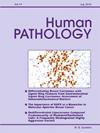化疗治疗的高级别浆液性癌的适应性免疫反应和PD-1/ PD-L1状态依赖于化疗反应评分
IF 2.6
2区 医学
Q2 PATHOLOGY
引用次数: 0
摘要
背景:铂类化疗和减容手术是晚期输卵管卵巢高级别浆液性癌(HGSC)患者的标准治疗方案。化疗反应评分(CRS)系统是一种组织病理学评分系统,用于测量对新辅助化疗的反应和预后影响。高CRS的大网膜样本有较大的炎症细胞浸润,但浸润免疫细胞的免疫表型和残余肿瘤的PD-L1表达尚未明确。设计:选取20例FIGO IIIA ~ IIIC期HGSC患者,在接受3-4轮化疗后进行间歇减积。6/20例网膜标本为CRS 1级,7/20例为CRS 2级,7/20例为CRS 3级。进行以下免疫组化染色:CD8、CD4、Foxp3、PD1和PD-L1。记录肿瘤浸润淋巴细胞总数,并给予PD-L1联合阳性评分(CPS)和肿瘤比例评分(TPS)。结果:CRS 3评分组CD8+ T细胞、PD-1+ T细胞、CD4+ T细胞、Foxp3+ T细胞数量显著高于CRS 1评分组(p值分别为0.0018、0.0224、0.0071、0.0136)。CRS 3评分的患者PD-L1 CPS更高(CRS 3 CPS 13 +/- 8.2 vs CRS 1 CPS 0 +/- 0;假定值0.0485)。结论:对新辅助治疗有更大反应的输卵管卵巢高级别浆液性癌有更高的T细胞浸润和更高的PD-L1联合阳性评分,突出了CRS作为免疫检查点阻断治疗的预测性生物标志物的潜在作用。本文章由计算机程序翻译,如有差异,请以英文原文为准。
Adaptive immune response and PD-1/ PD-L1 status in chemotherapy treated high grade serous carcinoma is dependent on chemotherapy response score
Background
Platinum-based chemotherapy and debulking surgery is the standard of care for patients with advanced tubo-ovarian high-grade serous carcinoma (HGSC). The chemotherapy response scoring (CRS) system is a histopathologic scoring system developed to measure response to neoadjuvant chemotherapy with prognostic implications. Omental samples with high CRS have greater inflammatory cell infiltrates, but the immunophenotype of infiltrating immune cells and PD-L1 expression of the residual tumor has not been well-defined.
Design
Twenty cases of patients with FIGO stage IIIA to IIIC HGSC undergoing interval debulking after receiving 3–4 rounds of chemotherapy were selected. 6/20 cases of omental samples were graded as CRS 1, 7/20 were graded CRS 2, and 7/20 were graded CRS 3. The following immunohistochemical stains were performed: CD8, CD4, Foxp3, PD1, and PD-L1. The total number of tumor-infiltrating lymphocytes was recorded, and each case was given a PD-L1 combined positive score (CPS) and tumor proportion score (TPS).
Results
There was a significantly greater number of CD8+ T cells, PD-1+ T cells, CD4+ T cells, and Foxp3+ T cells in CRS 3-scored cases compared to CRS 1 scored cases (p-values: 0.0018, 0.0224, 0.0071, and 0.0136, respectively). CRS 3-scored cases had a greater PD-L1 CPS (CRS 3 CPS 13 ± 8.2 versus CRS 1 CPS 0 ± 0; p-value: 0.0485).
Conclusions
Tubo-ovarian high-grade serous carcinoma with greater response to neoadjuvant treatment have significantly greater T cell infiltrate and greater PD-L1 combined positive score, highlighting a potential role of the CRS as a predictive biomarker for immune checkpoint blockade therapy.
求助全文
通过发布文献求助,成功后即可免费获取论文全文。
去求助
来源期刊

Human pathology
医学-病理学
CiteScore
5.30
自引率
6.10%
发文量
206
审稿时长
21 days
期刊介绍:
Human Pathology is designed to bring information of clinicopathologic significance to human disease to the laboratory and clinical physician. It presents information drawn from morphologic and clinical laboratory studies with direct relevance to the understanding of human diseases. Papers published concern morphologic and clinicopathologic observations, reviews of diseases, analyses of problems in pathology, significant collections of case material and advances in concepts or techniques of value in the analysis and diagnosis of disease. Theoretical and experimental pathology and molecular biology pertinent to human disease are included. This critical journal is well illustrated with exceptional reproductions of photomicrographs and microscopic anatomy.
 求助内容:
求助内容: 应助结果提醒方式:
应助结果提醒方式:


